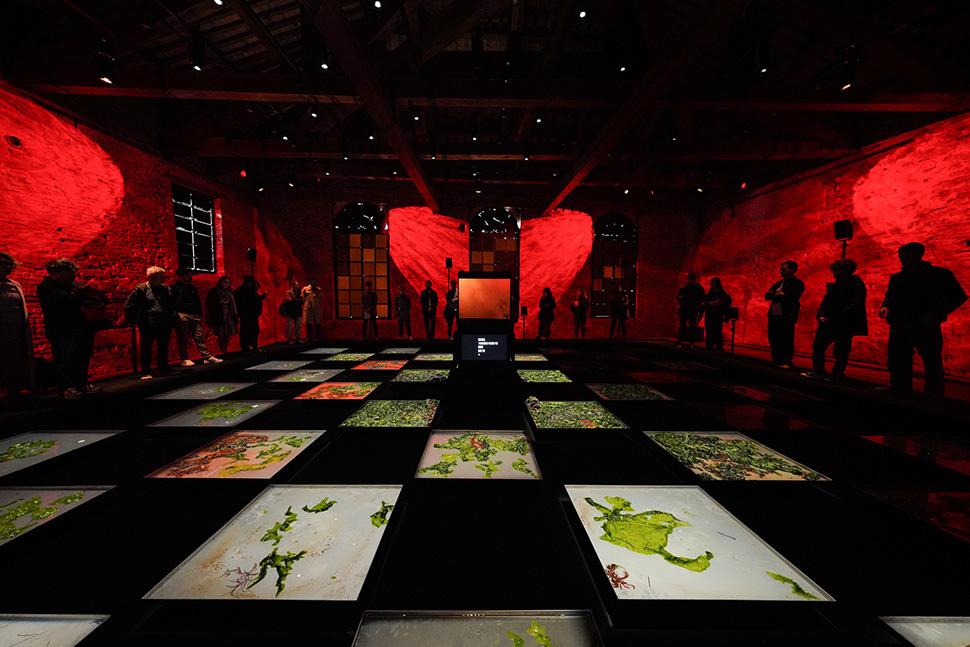| Year: | 2023, world premiere |
|---|---|
| Composition: | Alberto Anhaus |
| Production: | La Biennale di Venezia - CIMM, Centro di Informatica Musicale Multimediale |
Alberto Anhaus - Colonization-Sea Invasion

Description
Colonization – Sea Invasion is an installation which involves sound, smell and sight. These interacting parameters are used with the aim of raising questions in visitors and giving them something to reflect on. The idea is to establish a parallel between human life and that of the algae Agarophyton vermiculophyllum and Ulva lactuca, and to give a different perspective on a living creature that is often overlooked despite its importance to the lagoon’s ecosystem.
Visitors will interact with the representation of a post-apocalyptic environment surrounding the real protagonist: the seaweed. In an antechamber, a laboratory will be staged and graphs and data from the IPCC (Intergovernmental Panel on Climate Change) on the prospect of sea level rise will be displayed.
The next space will be the heart of the installation. It will contain various sensors that will collect data and ultimately trigger some elements within the installation. At the centre of the stage, an aquarium containing algae will be displayed. Some of its parameters, such as temperature and oxygen level in the water, will be influenced by the presence of the visitor. This aquarium will be surrounded by small containers filled with water and mud from the Venetian lagoon, and placed within a square formed by the walkways used in Venice in case of high tides.
Smell will also have a fundamental role in the installation: as an integral part of Venice’s identity, the smell of seaweed will be reproduced and diffused by electrical impulses directly linked to the movement and weight of the spectators.
Live sounds will come from three different sources: the sound of decomposition of dead algae placed inside the water and mud containers, amplified and manipulated; the sound of the changing photosynthetic states of the algae inside the aquarium; underwater recordings of boats passing on the Canal Grande.
Research Article
Invasion of alien macroalgae in the Venice Lagoon, a pest or a resource?
Adriano Sfriso (Department of Environmental Sciences, Informatics & Statistics, Ca’ Foscari University),
Alessandro Buosi, Marion Adelheid Wolf and Andrea Augusto Sfriso (Department of Chemical and Pharmaceutical Sciences, University of Ferrara)
e-mails: sfrisoad@unive.it (AS), alessandro.buosi@unive.it (AB), marion.wolf@unive.it (MAW), asfriso@hotmail.it (AAS)
Abstract
Alien macroalgae, mostly invasive species, are a constant concern for coastal areas, especially in the northern Adriatic Sea where several taxa have colonized the main transitional environments. A revision of the alien macroalgae in the Venice Lagoon shows that, currently, the number of valid non-indigenous species (NIS) is 29, and this number is growing steadily. On the basis of numerous surveys carried out in the last decade the total alien standing crop (SC) was estimated to be ca. 146,534 tonnes fresh weight (fw), i.e. 32% of the total species SC (ca. 456,000 tonnes fw) measured in May–June 2014 in the whole lagoon. The most abundant species were the invasive Agarophyton vermiculophyllum (approx. 66,383 tonnes fw), Agardhiella subulata and Hypnea cervicornis (approx. 36,714 and 28,305 tonnes fw, respectively). These species grow mainly free-floating and usually colonize the soft substrata of the lagoon. Two other invasive species, Sargassum muticum and Undaria pinnatifida, grow mainly on the docks of Venice historical centre, therefore their distribution is significantly more limited. Recent studies have shown that A. vermiculophyllum in protected, eutrophic areas produced a biomass of approx. 24 kg fw m-2 y-1. This species can replace Ulvaceae with positive effects on the environment and the presence of macrofaunal taxa. Indeed, historical data analysis shows that, despite the high presence of NIS, biodiversity is increasing. In addition, A. vermiculophyllum, S. muticum, U. pinnatifida, A. subulata and Solieria filiformis may be promising species for phycocolloid and antioxidant or cosmetic productions.